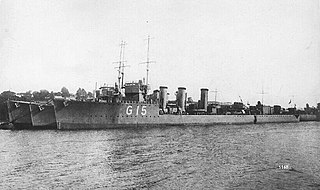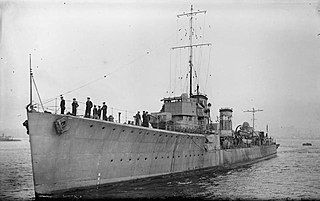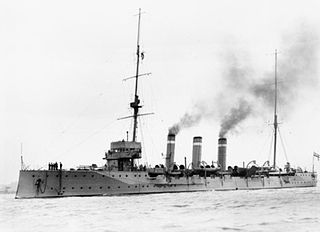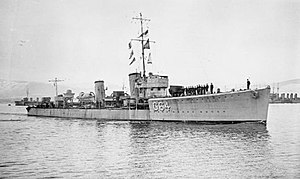
The first HMS Montrose was one of eight Admiralty-type destroyer leaders, sometimes known as the Scott class. They were named after figures from Scottish history; Montrose was named for the Graham Dukes of Montrose. She was built during the First World War, but was completed too late for service then. However, she had a long career in the inter-war years and saw extensive service during the Second World War.

HMS Romola was an R-class destroyer which served with the Royal Navy during World War I. Launched on 14 May 1916, the ship operated as part of the Grand Fleet, operating as part of a destroyer flotilla. The ship sailed to intercept the German High Seas Fleet in what would be one of the last major expeditions of their Navy in the war but saw no action. After the conflict, the destroyer was held in reserve until being retired and sold to be broken up on 13 March 1930.

HMS Rocket was an R-class destroyer which served with the Royal Navy during World War I. Launched on 2 July 1916 after being stuck on the slipway since 30 June, the ship joined the Grand Fleet, operating as part of a destroyer flotilla undertaking anti-submarine operations in the North Sea. Although the ship did not successfully engage any German submarines, there was an incident with the Royal Navy boat K7 on 16 June 1917, although that attack was aborted after the erstwhile target was identified as a friendly vessel. After the War, the destroyer served with the anti-submarine and torpedo schools at Portsmouth, and briefly during the Chanak Crisis of 1922, before being sold to be broken up on 16 December 1926.

HMS Speedy was a Thornycroft S-class destroyer which served with the Royal Navy during the First World War, Russian Civil War and the Greco-Turkish War. Speedy was one of a pair of destroyers ordered from Thornycroft with more powerful geared turbines and design changes like a raised forecastle that improved seakeeping. Launched on 1 June 1918, the vessel operated as part of the 12th Destroyer Flotilla of the Grand Fleet for the last months the War. After the Armistice, the vessel joined the Mediterranean Fleet and took part in actions in the Black Sea and Sea of Marmara. It was during action there that the ship struck a tug on 24 September 1922. The collision sank the destroyer, killing ten sailors.

HMS Tobago was a Thornycroft S-class destroyer which served with the Royal Navy during the Greco-Turkish War. Launched by Thornycroft on 15 July 1918, the vessel followed a design typical of the yard by being faster than the majority of the class, and also had better seakeeping properties thanks to a raised forecastle. The destroyer operated as part of the Grand Fleet for the last few weeks of the First World War, and, after the Armistice, joined the Mediterranean Fleet based in Malta. While serving in off the coast of Turkey, the ship hit a mine on 15 July 1920, exactly two years after being launched. Despite the relative youth of the vessel, the damage was deemed irrepairable and so Tobago returned to Malta and was sold for scrap on 9 February 1922.

HMS Tourmaline was a Thornycroft S-class destroyer, which served with the Royal Navy during the Greco-Turkish War and the Russian Civil War. Tourmaline was one of three destroyers ordered from Thornycroft in June 1917 with more powerful geared turbines than the majority of the class as well as design changes that improved seakeeping. Launched on 19 April 1919, the vessel operated as part of the Fourth Destroyer Flotilla serving with the Atlantic and Mediterranean Fleets. After serving in the Black Sea and Sea of Marmara, during which sister ships Speedy and Tobago were lost, Tourmaline led the Gibraltar Local Defence Flotilla. The London Naval Treaty, signed 1930, required the retirement of some destroyers to meet the Royal Navy's tonnage requirement and Tourmaline was chosen for retirement. The destroyer was decommissioned on 28 November 1931 after 12 years of service and broken up.

HMS Sturdy was an S-class destroyer, which served with the Royal Navy. Launched in 1919, the destroyer visited the Free City of Danzig the following year but then spent most of the next decade in the Reserve Fleet. After a brief period of service in Ireland in 1931, Sturdy was divested of armament in 1934 and equipped with a single davit to rescue ditched aircraft, and acted as plane guard to the aircraft carrier Courageous. The ship subsequently took part in the 1935 Naval Review. Re-armed as a minelayer, the destroyer was recommissioned the following year and reactivated at the start of the Second World War. Sturdy was then employed escorting convoys in the Atlantic Ocean, but ran aground off the coast off the Inner Hebrides island at Tiree in 1940. The vessel was split in two by the waves. The crew evacuated, apart from three sailors who died, and the destroyer was lost.

HMS Tara was an S-class destroyer, which served with the Royal Navy. Launched on 7 August 1918, the vessel entered service at the closing of the First World War. The ship joined the Fourteenth Destroyer Flotilla of the Grand Fleet but was placed in Reserve at Nore in 1919. Tara deteriorated over the following years and was sold to be broken up on 17 December 1931 after the signing of the London Naval Treaty that limited the amount of destroyer tonnage the Navy could retain.

HMS Swallow was an S-class destroyer, which served with the Royal Navy. The S class were a cheaper and faster alternative to the larger V and W class most recently procured by the service. Launched on 1 August 1918, Swallow took part in one of the final acts of the Harwich Force on 1 October as part of a flotilla that unsuccessfully tried to intercept the retreating German troops. After the armistice, Swallow was transferred to the Mediterranean fleet and served in the Black Sea covering the evacuation of demobilised forces from Batumi and Marmara Ereğlisi. Returning to the United Kingdom in 1923, the vessel was placed in reserve until 1936. On 24 September in that year, after just under eighteen years in service, Swallow was one of the destroyers exchanged for RMS Majestic and subsequently broken up at Inverkeithing.

HMS Serapis was an S-class destroyer, which served with the Royal Navy during the Greco-Turkish and Russian Civil Wars. Launched on 17 September 1918, the vessel was not completed until after the closing of the First World War. The ship joined the Seventh Destroyer Flotilla in the Reserve Fleet at Rosyth. The ship was then commissioned and sent to Constantinople to support refugees escaping from the conflicts in the Black Sea. The destroyer assisted in the evacuation of the Crimea in 1919 and helped rescue about nine hundred people from Smyrna in 1922. In 1929, Serapis was transferred to Hong Kong to serve in China. However, the signing of the London Naval Treaty in 1930 meant that the Royal Navy looked to retire older vessels. Serapis was sold to be broken up on 25 January 1934.

HMS Tribune was an S-class destroyer that served with the Royal Navy during the Russian Civil War. Launched in 1918, the vessel entered service with the Aegean Squadron of the Mediterranean Fleet. Tribune saw no action during the First World War but was involved in supporting the evacuation of refugees from the Russian Civil War, particularly from Crimea in 1920 and 1921. The ship also visited Constantinople in 1920 and 1922 during the Turkish War of Independence. In 1923, the destroyer was transferred to the Atlantic Fleet. In 1929, the ship took part in simulated amphibious warfare with the Territorial Army. In 1930, the signing of the London Naval Treaty required the Royal Navy to retire older destroyers before acquiring new ones. Tribune was one of those chosen for retirement and, in 1931, the destroyer was sold to be broken up.

HMS Trinidad was an S-class destroyer that served with the Royal Navy. The ship was named after the island in the West Indies. Launched on 8 May 1918, the vessel entered service with the Grand Fleet but saw no action during the during the First World War. After the Armistice, Trinidad joined the Mediterranean Fleet. War had broken out between Greece and Turkey and there was intelligence that the Soviet Union was selling warships to one of the belligerents. Trinidad was part of a small flotilla that was sent to investigate and, ultimately, halt this trade. However, it turned out to be a hoax. The destroyer subsequently returned to Constantinople. In 1930, the signing of the London Naval Treaty required the Royal Navy to retire older destroyers before acquiring new ones. Trinidad was one of those chosen for retirement and, on 16 February 1932, the destroyer was sold to be broken up.

HMS Sepoy was an S-class destroyer, which served with the Royal Navy during the First World War and the Russian Civil War. Sepoy was launched in 1918 and initially joined the Grand Fleet. After the Armistice that ended the First World War, the ship was briefly transferred to the Reserve Fleet before sailing to Tallinn in 1919 as part of the Royal Navy response to the fighting there. Sepoy rejoined the Reserve Fleet at the end of the year. In 1922, the destroyer served in the Mediterranean Sea. The ship was later allocated to the naval base in Hong Kong, arriving in 1929. During exercises the following year, a depth charge explosion killed six sailors. The destroyer was also damaged. Following the signing of the London Naval Treaty a few days later, Sepoy returned to the United Kingdom and, in 1932, was sold to be broken up at Newport, Wales.

HMS Senator was an S-class destroyer, which served with the Royal Navy during the First World War, Greco-Turkish War and Russian Civil War. The S class were a development of the previous R class, and Senator was the first of six constructed by Denny. Senator was launched on 2 April 1918 and joined the Mediterranean Fleet. After the Armistice that ended the First World War, the destroyer continued to serve in active duty, both in the Mediterranean and the Black Seas. For example, in 1919, the ship helped cover the evacuation of Russian troops from Batumi. In 1925, Senator was placed in reserve and, in 1936, was given to Thos. W. Ward of Sheffield in part-exchange for the liner RMS Majestic.

HMS Seraph was an S-class destroyer, which served with the Royal Navy during the Russian Civil War. The S class were a development of the previous R class, with minor differences, constructed at the end of the First World War. Seraph had a career as an evacuation vessel more than as a warship. Launched in 1918 by Denny, Seraph was originally destined for the Grand Fleet but, after the Armistice, the destroyer transferred to the Mediterranean Fleet based at Malta. The destroyer was sent into the Black Sea to support the White Russian forces in their fight against the Communists. The role involved supporting the movement of troops rather than firing at the enemy. Ultimately, the Communists won and Seraph helped the evacuation of White Russian troops from Crimea, returning to Malta in 1921. The destroyer was then stationed in the Eastern Mediterranean in 1923 in response to the tensions in Turkey. In 1927, the ship was sent to Hong Kong to serve under the Commander-in-Chief, China. In 1929, the vessel was once again called to evacuate, this time Christian missionaries from the Chinese Red Army. Once again, the evacuation took place without bloodshed. With the introduction of more modern destroyers, the Royal Navy started retiring the S class and, in 1934, Seraph was sold to be broken up.

HMS Sesame was an S-class destroyer, which served with the Royal Navy in the twentieth century. Launched on 30 November 1918 just after the end of the First World War, the ship was commissioned into the Reserve Fleet. A year later, the destroyer was sent to Latvia in support of the country's call for independence, arriving just at the cessation of that county's war of independence. Returning to the United Kingdom, Sesame was later equipped to act as a plane guard within the Home Fleet, with all armament removed and a davit fitted to rescue aircraft. The vessel remained in that configuration for a short time, but the London Naval Treaty sounded the death knell for the ship as it limited the destroyer tonnage that the Royal Navy could operate. As newer and more powerful destroyers entered service, Sesame was one of those retired, being sold to be broken up on 4 May 1934.

HMS Topaze was a Topaze-class protected or third-class cruiser which served in the Royal Navy during the First World War. The vessel was the lead ship of the class, also known as the Gem class, which had a more powerful armament and were faster than preceding protected cruisers. Launched on 23 June 1904, Topaze joined the Channel Fleet and often acted as a flotilla leader for the destroyers of the Navy. At the beginning of the First World War, the cruiser operated with the Fifth Battle Squadron, but was transferred to the Mediterranean Fleet in 1915. There, the cruiser operated with ships of the Italian Regia Marina to enforce the blockade on Albania and to escort ships carrying Italian troops and supplies across the Adriatic Sea. Topaze escorted shipping in the Indian Ocean and captured the Ottoman Army garrison on the island of Kamaran in 1917, but returned to the Mediterranean before the end of the year. After the Armistice in 1918, the cruiser returned to the United Kingdom and was decommissioned on 7 October 1919.

HMS Northesk was an Admiralty M-class destroyer which served in the Royal Navy during the First World War. The M class was an improvement on the previous L-class destroyer, capable of higher speed. The vessel was launched in 1916 and joined the Grand Fleet. Northesk was involved in escorting convoys, including the first southbound convoy on the coastal route between Lerwick and Immingham in 1917. After the Armistice that marked the end of the First World War, the destroyer joined the Mediterranean Fleet and operated in the area around Sevastopol, including assisting in the evacuation of the Crimea in 1919. Soon afterwards, in 1921, Northesk was decommissioned and sold to be broken up.

HMS Redpole was one of 20 Acorn-class destroyers built for the Royal Navy that served in the First World War. The Acorn class were smaller than the preceding Beagle class but oil-fired and better armed. Launched in 1910, the ship served with the Second Destroyer Flotilla, joining the Grand Fleet at the start of the war, and was transferred to the Mediterranean Fleet in 1915, joining the Fifth Destroyer Flotilla. Employed as an escort, the ship also undertook other duties, including rescuing the Italian destroyer Benedetto Cairoli in 1918. Redpole ended the war in Gibraltar. After the Armistice, the destroyer was placed in reserve before being sold to be broken up in 1921.

HMS Searcher was an S-class destroyer that served with the Royal Navy during the Russian Civil War. The S class was a development of the previous R class, with minor differences, constructed at the end of the First World War. Searcher was launched in September 1918 and joined the Grand Fleet days after the end of the War. The destroyer then joined the British campaign in the Baltic, sailing as part of a detachment of ten destroyers under the command of Admiral Walter Cowan in March 1919. Searcher sailed to Tallinn in support of the Estonian War of Independence the following month. On returning to the UK, the ship was placed in reserve. In 1931, the destroyer resumed active service and joined the defence flotilla at Gibraltar, and, subsequently, the Mediterranean Fleet, accompanying ships like the aircraft carrier Glorious and the dreadnought Queen Elizabeth on cruises around the Mediterranean Sea. The vessel also took part in the naval review to celebrate the Silver Jubilee of George V in 1935. Searcher was sold to be broken up in 1938.













